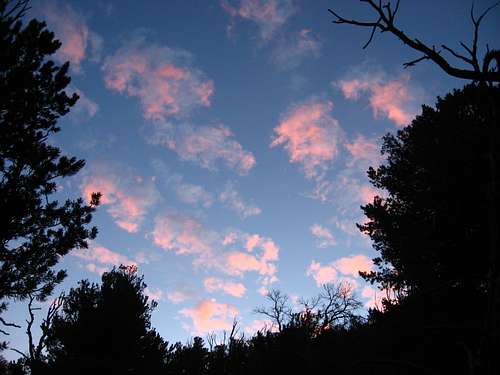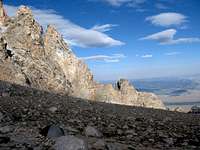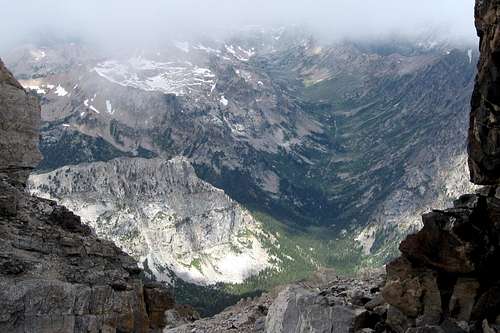After smearing some cold Chapstick on my cracked lips, I took a moment to look at the sky. Morning was just beginning to appear over the ridge, and sunlight painted the few stray clouds a brilliant shade of pink. “Wow, sunrises never get old,” I thought as I continued up the southwest ridge of Borah Peak.
![Borah Peak Trail]() Steep trail winding its way up Chicken-Out Ridge on Borah Peak.
Steep trail winding its way up Chicken-Out Ridge on Borah Peak.![Light Dance]() Morning light on an attractive peak neighboring Borah.
Morning light on an attractive peak neighboring Borah.
My pace was deliberate, yet somewhat slowed by the tightness in my legs. I knew exactly why I was sore, but in some way the previous three days seemed very distant from reality. Was I really on the summit of the Grand Teton just two days ago? How did I end up here on the steepest trail I’ve ever seen, at six thirty in the morning? Immediately, I was swept away in a whirlwind of thought as I fell back into the monotony of kicking my feet into the loose hillside that rose up abruptly in front of me.
***
The trip to Paul’s house in Alta, Wyoming went much faster than I remembered it going the year before. After meeting through a friend at Brigham Young University, Paul and I had had many memorable climbing experiences. Not the least of these was last year’s trip to climb the Grand, when we were forced to turn back after camping at the Lower Saddle due to relentless rain storms. We were disappointed, yet determined to return the next chance we had and see the summit of the Grand Teton.
Now was our chance, and we had come prepared for the weather by giving ourselves two days to summit instead of just one. Wednesday morning found us at the Jenny Lake Ranger Station getting our backcountry permit, excited for our second go on the Grand. On our way out, we took a minute to look at the photos on the wall. A technical rescue on Petzoldt Ridge, Glenn Exum on the route named for him, and a climber summiting a snow-covered Grand Teton all heightened our sense of adventure and increased our appreciation for the rich history of Grand Teton National Park. What an experience this was going to be!
![les Trois Tétons]()
Lupine Meadows quickly faded out of sight below us as we climbed the broad switchbacks into Garnet Canyon. Our packs were loaded with climbing and camping gear, but we hardly felt them as we moved through the boulder field, passed the meadows and caves, and wound our way up the moraine. Climbing Wasatch eleveners had proven to be a worthy form of training, and I was happy that I was able to enjoy our hike to the Lower Saddle.
After about five hours of hiking, we reached our destination and set up camp. The weather was already looking better than the previous year, and there was no sign of thunderstorms Wednesday afternoon and evening. As the evening wore on, however, the wind began to pick up and we realized that we were in for another windy night on the Saddle.
I never thought a tent could make as much noise as ours did in the increasingly violent gusts of wind. Not only the noise, but the walls of the tent constantly whipping our faces and throwing gear on top of us made it nearly impossible to sleep. This was some serious wind! Eventually I somehow drifted off and got a couple hours of rest before the alarm went off, letting me know that 4 am had finally arrived and it was time to get moving.
The wind was as strong as ever, tearing at our jackets as we climbed towards the Black Dike. Everything was dark, and on both the Idaho and Wyoming sides of the saddle all we could see were a few faint lights flickering in the distance. I was forced to brace myself several times, not because of the steep terrain, but because of unexpected wind gusts that nearly knocked me off my feet.
![Looking back at Middle Teton]() Looking back toward Middle Teton.
Looking back toward Middle Teton.
Things calmed down considerably as we scrambled up the more sheltered couloir above the Dike and approached the towering feature called the Needle. Both of us had the route description more or less memorized and did our best to find the tunnel behind the large boulder that composes the Eye of the Needle. Soon, however, we found ourselves soloing up some fairly technical faces in our attempt to find the tunnel. I couldn’t help but laugh to myself as I realized that the moves we were making here in the dark without any protection were probably much more difficult than anything we would encounter on the parts of the route we would be roped up for.
With some luck, we found the tunnel and squeezed through. We continued to wander up through the broken rock of the couloir, never once feeling like we were on route. Either way, we knew that the Upper Saddle was above us, and we pushed on. “It didn’t look this far away from the Lower Saddle,” was the thought that ran through my mind several times as I scrambled up the seemingly never-ending gully of loose rock.
After what felt like the longest scramble of my life, we were greeted with an icy blast of wind as we crested the Upper Saddle and caught our first glimpse of the tremendous exposure awaiting us on our climb to the summit. Several razor sharp ridges of jagged mountains lay before us and continued off into the horizon as far as we could see. I knew from studying the topo maps that these were no small peaks, but from our vantage point at 13,000 feet, they were dwarfed by the mass of vertical rock that is the Grand Teton.
![The Shadow of Giants]() The Tetons casting shadows in the early morning hours.
The Tetons casting shadows in the early morning hours.
The sky was clear and the sun was shining, but the wind chilled us to the core. We quickly lost our motion-induced body heat during the short break on the Upper Saddle, and we soon realized that neither of us really wanted to dig out the rope and climbing gear. It was so windy! Thoughts of last year raced through my mind, and I remembered that I had promised myself that I wouldn’t turn back this year unless conditions were truly dangerous. I knew that the Exum guides were ahead of us with a large group, and I could also see that there was no serious weather on the horizon. The determination brought on by these thoughts snapped me out of my body-heat-conserving lethargy and I sprung into action.
I am confident that Paul had the same inner struggle I did, but I could see that he was even more determined than I was to brave the howling wind and start climbing. Moving fast, we pulled on our harnesses, racked up, and built an anchor without saying much at all. Attempts to speak were nearly futile as the words were instantly ripped from our mouths. Paul and I had previously decided that if we lost sight of each other and could not communicate verbally, three sharp tugs on the rope would mean that I had reached the end of the pitch, built an anchor, and was ready for him to climb. He would then respond in a similar manner to let me know that he was climbing.
Following the Owen Spalding route, the first major obstacle I came to was the Belly Roll. I immediately recognized it from the route description and smiled as I realized what I was doing. With thousands of feet of empty air underneath my feet, I was making the same moves that Franklin Spalding and his party made in 1898 on their route to the summit. I was 100% focused on climbing at that point, and having a blast doing it. I couldn’t feel the wind anymore and knew that this was going to be the greatest mountain experience of my life.
The other side of the roll was much more protected from the wind, so instead of continuing to the crawl I set up a belay and brought Paul over. He was smiling with excitement and thankful for the lessened exposure to the wind. I moved on to the Belly Crawl and felt even more overwhelmed with the beauty of the climb than I had on the roll. This move was noticeably more exposed and I stopped for a second to look down between my feet. At this height, trees were indistinguishable; all I could see were patches of green splotched onto a broken gray canvas of rock. A silver thread of water wound its way through the bottom of the canyon. Absolutely amazing!
![Cascade Canyon]() Looking down on Cascade Canyon.
Looking down on Cascade Canyon.
Paul and I moved up through the Double Chimney and Owen Chimney. Solid gear, fun moves, and the fact that we were doing it all above 13,000 feet kept a permanent smile on my face. Sargent’s Chimney came next, and soon we found ourselves clambering over what were supposed to be the final boulders before reaching the summit. Completely enshrouded in clouds, we couldn’t see our destination but were doing our best to follow the maze of climber trails and remember the route description. It turns out that we didn’t head far enough north, and found ourselves crossing over to the east side of the summit ridge far too early. Below us was a steep snowfield that disappeared down into the clouds. We saw signs of traffic and decided to skirt around the top of the snow and keep climbing up toward what we hoped would be the summit.
Our situation became more and more precarious, however, and just before turning around we caught a glimpse of rock through the clouds. There, about 200 feet farther up the ridge, was a towering needle of rock. It loomed ominously above us, and our hearts sunk. Cold, tired, and concerned about deteriorating weather, at this point the summit may as well have been a mile away. It was obvious that we were completely off track and that we had way more climbing ahead of us. The needle was clearly insurmountable, and the snowfield that lay between us and the needle was an obstacle that we were not equipped to deal with. Thus, we were forced to backtrack and climb onto the west side of the ridge, continuing our scramble upward.
The wind tore at us harder than ever, but we kept our heads up and kept moving. Much to my relief, it soon became apparent that we had found a well-used route and were heading the right direction. This was affirmed by two climbers who were on their way down from the summit. We were almost there! Laughing to myself, I remembered how I had had exactly the same thought over an hour ago at the top of Sargent’s Chimney.
Scrambling up through one last chimney, the terrain leveled considerably and it appeared that we might be at the… Yes! There it was, the USGS benchmark telling us that we had indeed reached the summit of the Grand Teton. Finally! After a year of waiting and hours of planning, packing, traveling, and climbing, we were there, on top. Other than finding the bench mark, we had no way of telling that we were actually standing at 13,770 feet above sea level. Our view was obscured by white fog in every direction, and the powerful wind kept us hunched down in the rocks, not wanting to be thrown down the seemingly bottomless drop-offs that surrounded us on all sides.
![Freezing in August]() Freezing in August – Paul’s face says it all. Grand Teton Summit.
Freezing in August – Paul’s face says it all. Grand Teton Summit.
After snapping a couple pictures and choking down some Clif Bars, we decided to head down. One of the parties we had met on our way up summited shortly after us, and we all agreed that we would team up for the rappels. The five of us cautiously made our way down the summit block, fighting our way through the increasingly intense wind. Almost nothing was said, and even at the Sargent’s Chimney rappel our communication was minimal as any attempt to speak above the roaring gale required extraordinary effort. Each of us was in our own little world—a cold world of broken granite and thick fog where we were intently focused on nothing but getting down.
![Sargent s Chimney Rappel]() Rappelling Sargent’s Chimney
Rappelling Sargent’s Chimney
Just above the main rappel, we ran into a very interesting situation. A middle-aged man passed us, climbing upward. Tethered to his harness by a daisy chain was his seven year-old son, who was shivering and obviously terrified. What was he thinking!? The boy didn’t even have gloves on, and his pants were flapping against bare legs. The weather had shown no signs of letting up, and they still had a long way to go. After very strong persuasion from a member of our party, the father decided to turn around and join us on the main rappel.
Now came another challenge—throwing our ropes. After rigging the anchor, we threw our ropes only to see the wind send the coils sailing. We were aiming for a small notch to our left, but the ropes were flung immediately to our right, flailing in a position closer to horizontal than vertical. In the time that had lapsed during several failed throws, the majority of the group had tried to take shelter. Looking around, I could see that the lack of movement was allowing the cold to take an even stronger grip on us.
As we debated how we were going to get our ropes situated, we were met by an Exum guide, who suggested that we lower everyone down. He offered to do all the lowering, after which he would rappel. We were very thankful for his offer and wondered why we hadn’t thought of lowering sooner. The weight of a person on the rope end would keep it from being carried away by the wind, and once both ends were down, the rappel would be ready to go. Mike (the guide) made quick work of the anchor, and asked that the father and son be lowered first.
The clouds were still thick, completely obscuring our view of anything below us. This made the free-hanging rappel feel like a drop into oblivion, and the boy wanted nothing to do with it. Kicking and screaming, we lifted him into his father’s arms and they backed toward the ledge. The look on the boy’s face was one of sheer terror, and even above the roaring wind we could hear him screaming as he and his father dropped out of sight.
The rest of us soon found ourselves at the base of the main rappel, out of the clouds and into the sunshine. The wind was still a force to be reckoned with, however, and we began our long descent to the Lower Saddle. We thanked Mike for his help and he hurried ahead to assist the father and son.
What a day! It was only noon but it felt like I’d been awake for three days. As I scrambled down through the rocks, I began to relax and enjoy the moment. We had done it; we had reached our goal which had eluded us the year before. Every ounce of effort we put into reaching the summit was well worth it, and made our experience that morning all the sweeter. It was a windy day on the Grand Teton that I will never forget.
***
Standing on top of Borah Peak, the roof of Idaho at 12,662 feet, I find myself having a much different summit experience than I’d had two days earlier. Clear as a bell, the blue sky let the sunshine spill onto the valley floor around me. I could see for miles and miles in every direction, and quickly identified some of the other ranges I’d hiked in. This was another momentous day for me, as I had attempted Borah at the age of sixteen, only to find that I was physically unable to reach the top.
![Cloud Shadows]() Cloud shadows seen from Borah Peak.
Cloud shadows seen from Borah Peak.
Tackling these two awe-inspiring mountains in three days was one of the most demanding and difficult things I’ve ever done. With aching knees and bloodshot eyes I made the last few steps to the car and climbed inside. A wave of fatigue washed over me; all I wanted now was sleep, but as I leaned my head back against the headrest, a smile found its way to my lips.
Awesome. Unforgettable. I’d do it all again in a heartbeat.
![Grand Teton Summit]() Grand Teton Summit
Grand Teton Summit![Taking in the Moment]() Taking in the view from Borah Peak.
Taking in the view from Borah Peak.



























Comments
Post a Comment